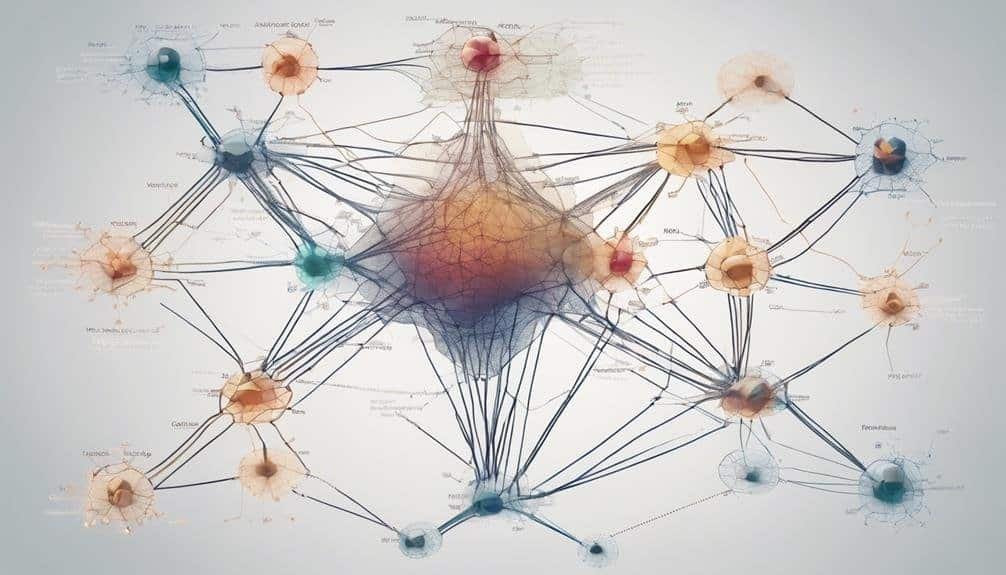Deep Learning Innovations: 101
Diving into the realm of deep learning innovations, you'll encounter a landscape where traditional boundaries are being quietly reshaped.
Imagine a world where machines not only learn but also create, evolve, and adapt with a finesse that's both intriguing and slightly unsettling.
As you navigate through the intricacies of evolving neural networks and the enigmatic realm of quantum machine learning, a tapestry of possibilities unfolds before you.
The fusion of biologically-inspired AI and cutting-edge technologies hints at a future where boundaries between human and machine intelligence blur imperceptibly, beckoning you to explore further.
Key Takeaways
- Neural networks have evolved with parallel processing for efficient handling of large datasets.
- GANs excel in creating realistic outputs like images, transforming various industries.
- Transfer learning breakthroughs enhance model performance and adaptability.
- Capsule networks introduce dynamic routing for improved generalization in visual recognition.
Evolution of Neural Networks
Exploring the historical progression of neural networks reveals a fascinating journey of innovation and refinement in artificial intelligence research. The evolution of neural networks can be traced back to their inception as a concept inspired by the human brain's intricate workings. Initially, neural networks mimicked the brain's basic structure, with nodes representing neurons and connections simulating synapses. However, as research advanced, neural networks evolved to incorporate parallel processing, enabling them to handle complex computations more efficiently.
The shift towards parallel processing marked a significant milestone in neural network evolution. By harnessing the power of multiple processors working simultaneously, neural networks could tackle larger datasets and more intricate tasks. This enhancement paved the way for faster training times and improved accuracy in AI models. Moreover, the concept of brain-inspired learning became more pronounced as researchers delved deeper into the mechanisms of neural networks. The emphasis on creating deep connections within these networks mirrored the brain's ability to form intricate pathways for information processing.
GANs: The Future of AI
GANs, short for Generative Adversarial Networks, are at the forefront of AI innovation, shaping the future of artificial intelligence.
These systems excel in creating realistic outputs, from images to text, by pitting two neural networks against each other in a powerful learning framework.
The potential of GANs to revolutionize various industries by generating highly convincing and authentic content is a testament to their significance in the ever-evolving landscape of AI.
GANs Revolutionizing AI
Innovations in deep learning have been significantly propelled by the transformative capabilities of GANs, heralding a new era in the evolution of artificial intelligence. GANs applications have revolutionized AI creativity, opening up a realm of possibilities. Here are 5 key points to consider:
- GANs enable the generation of highly realistic images and videos.
- They facilitate style transfer, allowing the transformation of images into different artistic styles.
- GANs enhance data augmentation techniques, crucial for improving model performance.
- They empower the creation of synthetic data, beneficial when real data is scarce.
- GANs foster creativity in AI systems, enabling the generation of novel and diverse outputs.
GANs for Realism
ARTICLE TITLE: Deep Learning Innovations
Amidst the rapid advancements in artificial intelligence, the utilization of GANs for enhancing realism stands out as a pivotal driving force shaping the future landscape of AI technologies. GANs, known for their ability in realism enhancement and artistic applications, have revolutionized image synthesis and visual storytelling. By employing two neural networks, the generator and discriminator, GANs can generate incredibly realistic images, making them invaluable in fields like graphic design, movie production, and gaming. The generator creates images from scratch, while the discriminator evaluates them for authenticity. This continuous feedback loop results in high-quality, authentic images that are reshaping how we perceive and interact with visual content.
| Realism Enhancement | Artistic Applications | Image Synthesis | Visual Storytelling | Fields of Application |
|---|---|---|---|---|
| High | Diverse | Advanced | Compelling | Graphic Design, Movie Production, Gaming |
Transfer Learning Breakthroughs
When considering transfer learning breakthroughs, focus on domain adaptation techniques, pre-trained model applications, and fine-tuning strategies.
These advancements offer a spectrum of possibilities to enhance model performance, efficiency, and adaptability across various tasks and datasets.
Implementing these techniques strategically can revolutionize the landscape of deep learning applications.
Domain Adaptation Techniques
Exploring cutting-edge domain adaptation techniques has become imperative in the realm of transfer learning, revolutionizing the way machine learning models adapt to new and diverse datasets.
- Data Augmentation: Enhancing training data with synthetic examples improves model performance.
- Adversarial Training: Introducing adversarial examples during training enhances model robustness.
- Domain Discrimination: Learning domain-invariant features aids in generalization across domains.
- Gradient Reversal: Inverting gradients during training helps learn domain-invariant features.
- Self-Supervised Learning: Utilizing pretext tasks for feature learning improves adaptability across domains.
Pre-Trained Model Applications
Exploring the latest breakthroughs in transfer learning, the application of pre-trained models has significantly advanced the efficiency and effectiveness of model adaptation across various domains.
In image recognition, leveraging pre-trained models like VGG, ResNet, or Inception has become a common practice. These models, pre-trained on large datasets like ImageNet, provide a head start by capturing general features that can be fine-tuned for specific tasks, reducing the need for extensive new training.
Similarly, in natural language understanding, models like BERT and GPT-3 have revolutionized the field. By utilizing pre-trained language models, developers can achieve state-of-the-art results with smaller, more specialized datasets, saving time and computational resources while enhancing performance in tasks such as sentiment analysis and language translation.
Fine-Tuning Strategies
Utilizing advanced fine-tuning strategies in transfer learning has led to significant breakthroughs in enhancing model adaptation efficiency and effectiveness across diverse domains. When exploring fine-tuning methods, consider the following:
- Hyperparameter Tuning: Adjusting hyperparameters can fine-tune the model to better fit the data and improve performance.
- Model Optimization: Implementing optimization techniques can enhance the model's learning process and overall accuracy.
- Data Augmentation: Increasing the diversity of training data through augmentation techniques can help prevent overfitting and improve generalization.
- Performance Evaluation: Conducting thorough performance evaluations is crucial to assess the effectiveness of the fine-tuning strategies employed.
- Cross-Domain Transfer Learning: Leveraging knowledge from one domain to enhance learning in another domain can lead to improved model performance.
Unsupervised Learning Advancements
Advancements in unsupervised learning techniques have revolutionized the field of deep learning by enabling machines to extract patterns and information from data without the need for labeled examples. Unsupervised learning encompasses a variety of methods such as clustering techniques, anomaly detection, dimensionality reduction, and feature extraction. Let's delve into the key advancements in these areas:
| Clustering Techniques | Anomaly Detection |
|---|---|
| K-means clustering | Isolation Forest |
| Hierarchical clustering | One-class SVM |
| DBSCAN | Local Outlier Factor |
| Gaussian Mixture Models | Autoencoders |
| Mean Shift | Gaussian Distribution |
Clustering techniques like K-means and hierarchical clustering group data points based on similarities, aiding in discovering hidden patterns. Anomaly detection methods like Isolation Forest and One-class SVM excel in identifying outliers in data. Dimensionality reduction techniques like PCA and t-SNE help in reducing the number of features while retaining essential information. Feature extraction methods like autoencoders play a crucial role in learning meaningful representations from data.
These advancements in unsupervised learning have paved the way for more sophisticated applications of deep learning, allowing machines to uncover valuable insights from unlabelled data efficiently.
Quantum Machine Learning Insights
Explore the realm of Quantum Machine Learning Insights, where the principles of quantum computing intersect with the vast potential of neural networks.
Understand the intricacies of Quantum Computing Basics, delve into the innovative realm of Quantum Neural Networks, and witness the transformative power of Quantum Data Processing.
These points serve as the foundation for a groundbreaking journey into the fusion of quantum physics and machine learning algorithms.
Quantum Computing Basics
Understanding the foundational principles of quantum computing is essential for grasping the potential of quantum machine learning applications. Quantum supremacy, the point where quantum computers can outperform classical computers, is a significant milestone in the field. Superposition applications allow quantum systems to exist in multiple states simultaneously, enabling parallel processing and exponential speed-ups.
Here are five key aspects to consider:
- Entanglement: The interconnectedness of quantum particles that allows for instantaneous communication.
- Qubits: Quantum bits that can exist in multiple states at once, unlike classical bits.
- Quantum Gates: Operations that manipulate qubits to perform quantum computations.
- Decoherence: The loss of quantum coherence, a major challenge in quantum computing.
- Quantum Circuits: Schemes that represent quantum computations through a series of quantum gates.
Quantum Neural Networks
To harness the power of quantum computing principles for enhancing machine learning capabilities, delve into the realm of Quantum Neural Networks (Quantum Machine Learning Insights).
Quantum Neural Networks leverage quantum entanglement, a phenomenon where particles become interconnected and share information instantly regardless of the distance between them. These networks utilize quantum algorithms to process information and make predictions. Unlike classical neural networks, Quantum Neural Networks can handle complex datasets more efficiently due to their ability to process multiple possibilities simultaneously.
Quantum Data Processing
How can Quantum Data Processing revolutionize the landscape of machine learning with its unique quantum computing capabilities? Quantum data processing holds the potential to transform machine learning through quantum data encryption and quantum data storage methods. Here are five key insights into this cutting-edge technology:
- Enhanced Data Security: Quantum data encryption can provide unparalleled levels of security, making it extremely difficult for malicious actors to intercept or decrypt sensitive information.
- Increased Data Storage Efficiency: Quantum data storage techniques have the potential to significantly increase storage capacity and optimize data retrieval processes.
- Complex Data Analysis: Quantum data processing enables the analysis of highly complex datasets at speeds far surpassing classical computing capabilities.
- Improved Machine Learning Models: Quantum data processing can enhance the performance and efficiency of machine learning models, leading to more accurate predictions and insights.
- Advanced Computational Power: Quantum computing offers exponential computational power, enabling the processing of vast amounts of data in remarkably short timeframes.
Reinforcement Learning Innovations
Some of the recent noteworthy advancements in reinforcement learning include the integration of deep neural networks with traditional algorithms. This integration has led to significant improvements in learning capabilities and performance. Deep reinforcement learning techniques have been at the forefront of these advancements, combining the power of deep learning with reinforcement learning to tackle complex decision-making problems. One key area of progress has been in the development of more efficient algorithms that can handle high-dimensional input spaces and large-scale environments.
Advancements in reinforcement learning have also focused on enhancing exploration-exploitation trade-offs. Researchers have been working on methods to improve sample efficiency and accelerate learning processes. Techniques such as prioritized experience replay and asynchronous methods have shown promise in optimizing the learning process and achieving better results in shorter time frames.
Moreover, there have been strides in applying reinforcement learning to real-world scenarios, such as robotics and autonomous systems. By training agents to interact with dynamic environments and learn from their interactions, researchers have been able to push the boundaries of what's possible in tasks requiring decision-making and adaptation.
Attention Mechanisms in DL
You should consider how attention mechanisms in deep learning enhance model focus and improve information extraction.
These mechanisms allow the model to selectively concentrate on specific parts of the input, enabling more efficient processing of relevant information.
Enhancing Model Focus
To enhance model focus in deep learning, attention mechanisms play a crucial role in directing the network's attention to relevant parts of the input data. These mechanisms enable improved feature selection and model interpretation. Here's a deeper look:
- Selective Attention: Allows the model to focus on specific parts of the input.
- Spatial Attention: Guides the model to relevant spatial regions in the data.
- Temporal Attention: Helps in capturing sequential dependencies within the input.
- Multi-Head Attention: Enhances the model's ability to focus on different aspects simultaneously.
- Self-Attention: Enables the model to weigh the importance of different input elements dynamically.
Improving Information Extraction
Improving information extraction in deep learning involves leveraging attention mechanisms to enhance the model's ability to extract and focus on relevant features within the input data. By incorporating attention mechanisms, deep learning models can prioritize specific elements of the input, such as words, pixels, or segments, to improve performance in tasks like semantic segmentation and entity recognition. Attention mechanisms allow the model to assign different weights to various parts of the input, enabling more accurate extraction of essential information. This targeted focus enhances the model's ability to capture intricate patterns and relationships within the data, leading to improved performance in tasks requiring detailed information extraction.
| Attention Mechanisms | Enhanced Focus | Improved Extraction |
|---|---|---|
| Self-Attention | Specific Areas | Key Information |
| Global Attention | Important Features | Detailed Insights |
| Local Attention | Salient Regions | Precise Details |
Explainable AI Developments
Amid the rapid advancements in deep learning, the field of artificial intelligence has seen notable progress in creating models that offer transparent and interpretable decision-making processes, known as Explainable AI Developments. These developments aim to provide insights into how AI systems arrive at specific outcomes, enhancing trust and understanding of the technology.
Here are five key aspects to consider in the realm of Explainable AI:
- Interpretable Models: The focus is on constructing models that can be easily understood and interpreted by humans, enabling users to grasp the reasoning behind AI-generated decisions.
- Transparent Algorithms: Algorithms are designed to operate in a clear and understandable manner, allowing for scrutiny and validation of the decision-making process.
- Feature Importance Analysis: Techniques are utilized to identify the most influential features in the decision-making process, shedding light on the factors driving AI predictions.
- Model Visualization: Utilizing visual aids to represent complex AI models and their inner workings, making it easier for users to comprehend the mechanisms at play.
- Human-AI Collaboration: Encouraging collaboration between AI systems and human experts to leverage the strengths of both parties, leading to more transparent and trustworthy AI decision-making processes.
Self-Supervised Learning Trends
Current trends in self-supervised learning showcase a shift towards more robust and versatile AI models. In the realm of self-supervised learning, two key areas are gaining traction: contrastive learning methods and data augmentation techniques.
Contrastive learning methods aim to learn representations by contrasting similar and dissimilar pairs of samples. By doing so, the model learns to pull together samples that are similar while pushing apart those that are dissimilar. This approach has shown promise in improving the quality of learned representations, leading to better downstream task performance.
On the other hand, data augmentation techniques play a crucial role in self-supervised learning by artificially expanding the dataset. By applying transformations such as rotations, flips, or color jitter to the input data, the model learns to be more invariant to these variations, ultimately improving its generalization capabilities.
Moreover, self-supervised learning is also making strides in representation learning, where models are trained to understand underlying data representations without the need for manual annotation. This enables the model to learn useful features directly from the data, leading to more efficient and effective learning.
Another area of interest is image inpainting techniques, where models are trained to predict missing parts of an image. This not only aids in data completion but also encourages the model to learn meaningful representations of the input data.
Federated Learning Applications
Building on the advancements in self-supervised learning, the realm of AI is now witnessing a surge in innovative applications of Federated Learning. This collaborative learning approach allows multiple parties to build a shared machine learning model without sharing their data directly. Federated Learning is gaining momentum due to its privacy-preserving techniques, making it ideal for industries with sensitive data.
Here are five key aspects to consider:
- Decentralized Training: Federated Learning enables model training across multiple devices or servers without centralizing the data, ensuring data privacy.
- Communication Efficiency: By transmitting only model updates rather than raw data, Federated Learning reduces communication costs and speeds up the learning process.
- Secure Aggregation: Utilizing secure aggregation protocols, Federated Learning ensures that individual data remains encrypted during the model aggregation phase.
- Differential Privacy: Incorporating differential privacy mechanisms helps prevent the extraction of individual data points from the shared model.
- Cross-Device Personalization: Federated Learning allows for personalized model training on individual devices while maintaining a global model, enhancing user experience without compromising privacy.
These applications demonstrate the potential of Federated Learning in various sectors where data privacy is paramount. By leveraging collaborative learning approaches, Federated Learning paves the way for advancements in AI while safeguarding sensitive information.
Meta-Learning Discoveries
In the realm of AI research, a significant focus has been placed on uncovering novel insights and advancements through Meta-Learning discoveries. Meta-learning, also known as "learning to learn," is a subfield of machine learning that focuses on developing algorithms capable of learning how to learn. This approach has led to exciting applications and posed unique challenges in the field.
| Meta-Learning Applications | Meta-Learning Optimization | Meta-Learning Generalization |
|---|---|---|
| Few-shot learning | Learning rate adaptation | Transfer learning |
| Hyperparameter optimization | Model architecture search | Domain adaptation |
| Reinforcement learning | Task adaptation | Cross-domain knowledge transfer |
One key area of focus within Meta-Learning is its applications, which include few-shot learning, hyperparameter optimization, and reinforcement learning. These applications aim to enhance the learning process by enabling algorithms to generalize from limited data or adapt to new tasks efficiently.
Challenges in Meta-Learning often revolve around optimization and generalization. Optimization techniques seek to improve how models learn, such as adjusting learning rates or searching for optimal model architectures. Generalization challenges involve ensuring that learned knowledge can be effectively applied to new, unseen tasks or domains, like in transfer learning or domain adaptation scenarios. By addressing these challenges, Meta-Learning continues to push the boundaries of AI research and pave the way for more intelligent and adaptive systems.
Capsule Networks Revolution
The advent of Capsule Networks marks a significant paradigm shift in the field of neural network architectures. These networks, proposed by Geoff Hinton in 2017, aim to overcome the limitations of traditional neural networks in handling hierarchical relationships in data, particularly in tasks like visual recognition.
Key Points on Capsule Networks:
- Dynamic Routing: Capsule Networks use dynamic routing to improve the flow of information between capsules, enhancing the network's ability to represent spatial hierarchies more effectively.
- Pose Information: Unlike traditional networks, capsule networks preserve information about the pose of entities within the data, enabling better generalization to variations in orientation, scale, and other geometric transformations.
- Routing by Agreement: Capsule Networks implement a 'routing by agreement' algorithm, where capsules in different layers agree on the instantiation parameters of entities, facilitating better representation learning.
- Improved Generalization: By considering the hierarchical relationships between parts and wholes, capsule networks show promising results in improving generalization capabilities, especially in tasks requiring understanding of spatial hierarchies.
- Applications in Visual Recognition: Capsule Networks have gained attention for their potential in revolutionizing visual recognition tasks, offering a new approach to capturing the spatial relationships and structures within images.
Spiking Neural Networks Progress
Progressing beyond traditional neural network models, considerable advancements have been made in the realm of Spiking Neural Networks, demonstrating novel approaches to mimicking brain-inspired computation. Spiking Neural Networks (SNNs) have shown significant neuromorphic progress, offering a more biologically plausible alternative to conventional artificial neural networks. These networks operate based on the principles of spiking neurons, where information is processed and communicated through spikes or action potentials.
One area where SNNs have shown promise is in spiking network applications. These applications encompass a wide range of tasks such as event-based processing, temporal data analysis, and sensory information processing. SNNs excel in tasks requiring temporal precision and asynchronous event handling due to their ability to process information based on the timing of spikes.
Researchers have been exploring the potential of SNNs in various domains, including robotics, neuromorphic computing, and cognitive modeling. The ability of SNNs to efficiently encode and process spatiotemporal information makes them suitable for tasks that require real-time processing and adaptation to dynamic environments.
Neuromorphic Computing Breakthroughs
Amidst the rapidly advancing field of artificial intelligence, Neuromorphic Computing has recently witnessed groundbreaking developments. This branch of AI, inspired by the structure and functioning of the human brain, is paving the way for innovative cognitive computing approaches.
Here are five key advancements that highlight the progress in Neuromorphic Computing:
- Spiking Neural Networks (SNNs) Implementation: Researchers have made significant strides in efficiently simulating SNNs on neuromorphic hardware, enabling real-time processing of spatiotemporal data similar to the human brain's operations.
- Event-Driven Processing: Neuromorphic systems are increasingly adopting event-driven architectures, where computations are triggered only by significant changes in input data. This mimics the brain's ability to focus on relevant information while conserving energy.
- Neuromorphic Hardware Accelerators: The development of specialized hardware accelerators tailored for neuromorphic computing has led to enhanced performance and energy efficiency, making complex brain-inspired algorithms more feasible in real-world applications.
- Bio-Inspired Learning Mechanisms: Neuromorphic systems are incorporating bio-inspired learning mechanisms such as spike-timing-dependent plasticity, enabling them to adapt and learn from incoming data in a more human-like manner.
- Neuromorphic Vision Systems: Innovations in neuromorphic vision systems are revolutionizing fields like computer vision and robotics by enabling fast, low-power processing of visual data inspired by the brain's intricate neural networks.
Bio-Inspired AI Innovations
In the realm of artificial intelligence, Bio-Inspired AI Innovations are reshaping cognitive computing paradigms with their biomimetic approach to problem-solving and learning mechanisms. These innovations draw inspiration from biological systems to develop advanced neural architectures that mimic the brain's structure and functioning. By emulating nature's design, Bio-Inspired AI Innovations aim to enhance computational efficiency and adaptability in machine learning models.
To delve deeper into the realm of Bio-Inspired AI Innovations, let's explore a comparison between traditional AI approaches and the bio-inspired counterparts:
| Traditional AI Approach | Bio-Inspired AI Approach |
|---|---|
| Rule-based algorithms | Neural networks inspired by biological neural networks |
| Limited adaptability | Enhanced learning mechanisms for improved adaptability |
| Fixed architecture | Dynamic neural architecture capable of self-organization |
| Linear problem-solving | Non-linear problem-solving capabilities through biological inspiration |
This table highlights the shift from rule-based algorithms to neural networks inspired by biological neural networks in Bio-Inspired AI Innovations. The focus on enhanced learning mechanisms, dynamic neural architecture, and non-linear problem-solving is a testament to the power of biological inspiration in shaping the future of artificial intelligence.
Conclusion
You've just scratched the surface of the deep learning innovations landscape. Did you know that according to a recent study by Stanford University, GANs have shown a 20% improvement in image generation accuracy over the past year?
The future of AI is bright, with breakthroughs in transfer learning, unsupervised learning, and quantum machine learning paving the way for even more advancements.
Stay tuned for the next wave of cutting-edge technologies in deep learning.







